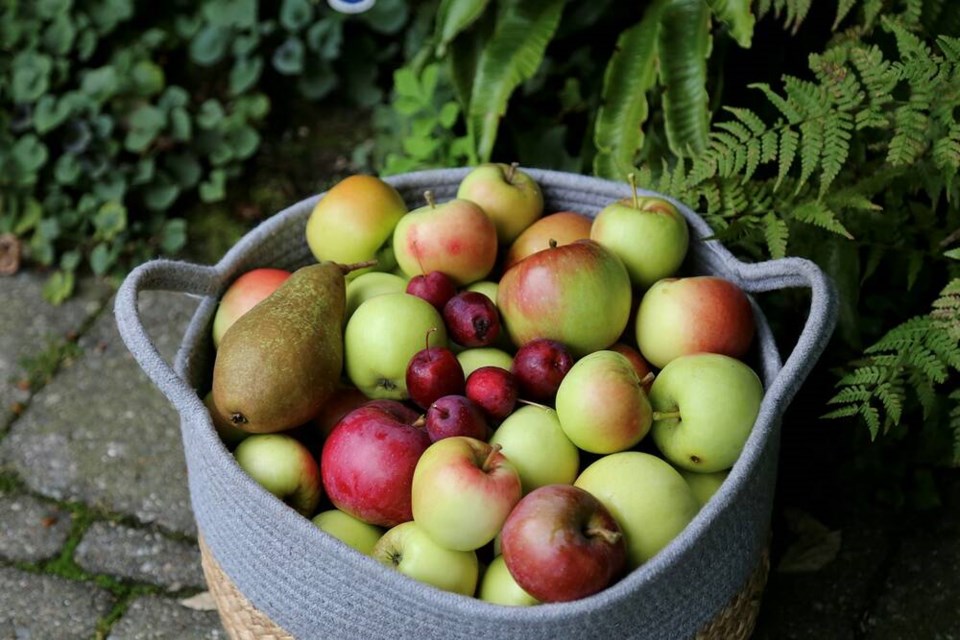If you own or rent a small patch of sun, you can grow apples. So-called dwarf fruit trees, a.k.a. patio apples, are gateway plants for budding urban permaculturists.
One of the first things I did when we committed to an urban permaculture make-over, was plant a dwarf fruit tree orchard. Dwarf and orchard are two words that you wouldn’t expect to read in the same sentence. But in my world, they belong together.
I’ve written about dwarf fruit trees before, but they warrant another go. Not only is the timing perfect for planting, but suddenly readers from all over are asking about sourcing and planting these diminutive darlings.
Dwarf fruit trees are not genetically modified, rather they are created by grafting standard fruit wood onto growth-regulated root stock. The process creates a size-controlled fruit tree that produces copious amounts of standard-size fruit, much earlier on average than so-called regular fruit trees.
A total of 16 dwarf trees planted strategically to advantage both sun and shade comprise our collection, namely: three guilds of three trees, underplanted with pollinator and predator-friendly herbs and living mulches, six interplanted in nearby beds, and one atop a hugelkultur mound. One dwarf crabapple, two pear, six apple, three plum, two cherry, one persimmon and one almond provide more than enough goodness for our family of five, plus thousands of native bees and other endangered pollinators.
A small, densely planted bed of blueberries, gooseberries, jostaberries and currants, blooms in succession nearby. Not so many days from now, when resident native bees chew through their cocoons in search of sustenance, the fruit and berry orchards will come alive with winged and buzzing things.
Until quite recently, dwarf fruit trees were relatively hard to come by. Today, however, Lower Mainland nurseries offer an impressive selection of both standard and columnar fruit trees on dwarf stock.
There is debate about whether dwarf or semi-dwarf root stock is optimal, but I believe that it matters little, if one stays on top of the thinning and pruning. That is, ensuring that the tree doesn’t grow higher than one can reach comfortably for maintenance, and also that interior branches are thinned to allow for cross-breezy air circulation.
Potted dwarf fruit trees are particularly easy to manage, as root growth is physically restricted. Our potted Fuyu persimmon fruited beautifully for its first two years, as well or better than after it was transplanted into the mound.
It is important to know going in that many varieties of peach, apricot and nectarine trees are self-pollinating, while others require pollination from another variety. Most but not all varieties of pear, apple, sweet cherry and plum require or can facilitate cross pollination.
An early-blossoming dwarf crabapple fills pollination gaps in our garden, but I always double-check my pollination guide before purchasing additional trees. Port Kells Nurseries in Surrey offers easy to follow, downloadable guides online – search “fruit tree pollination guide.”
If I had but one sunny patio with very limited space, I would choose a single dwarf apple tree onto which several varieties of pseudo self-pollinating fruit had been grafted. I would grow it in living soil, in the largest pot I could manage, and I wouldn’t stop there.
To mimic a tiny food forest and to help cool and insulate the soil, I would underplant with perennial flowering herbs and edible flowers. In spring and fall, nitrogen-fixing sugar snap and snow peas would ascend the trunk on cotton string. And finally, I would plant dwarf-style cherry or currant tomatoes to spill in colourful abundance, over the sides.
Laura Marie Neubert is a West Vancouver-based urban permaculture designer. Follow her on Instagram @upfrontandbeautiful, learn more about permaculture by visiting her Upfront & Beautiful website or email your questions to her here.
For a taste of permaculture, watch the video below:




